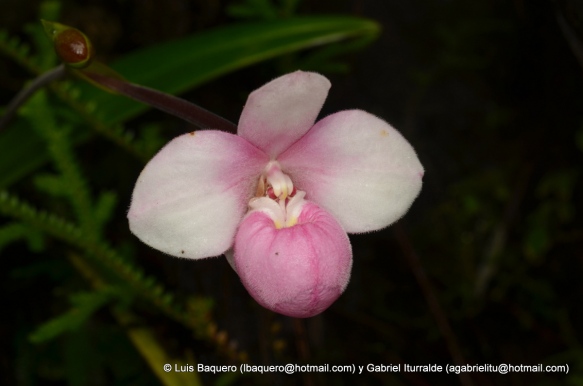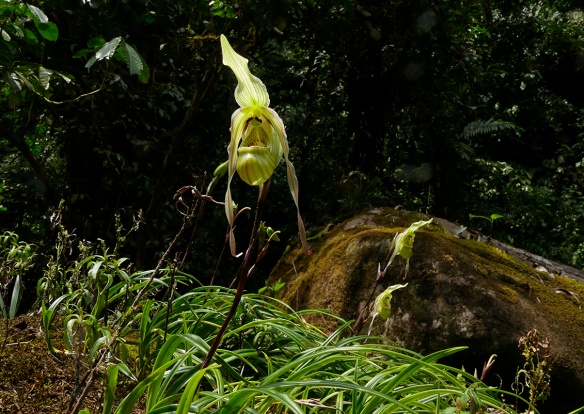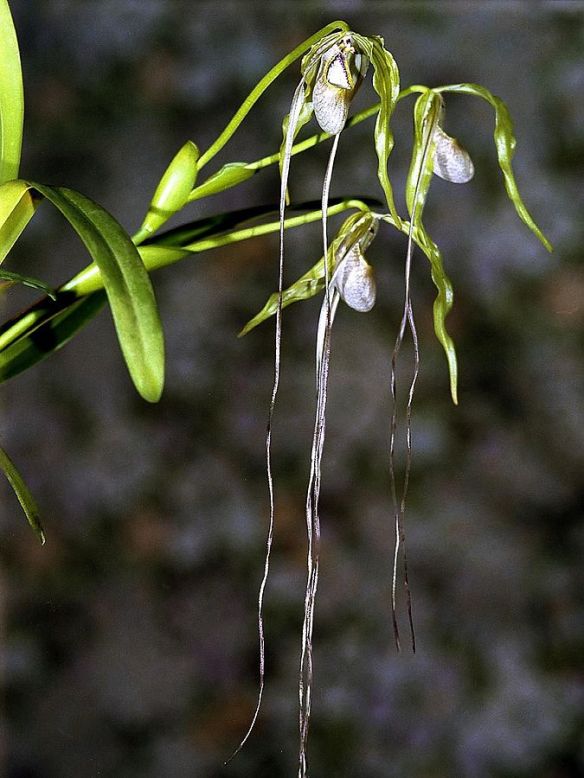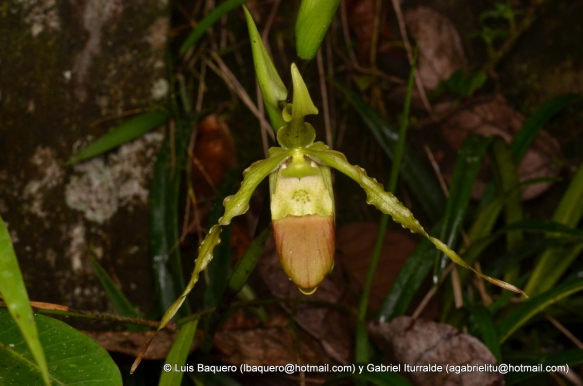
Phragmipedium fischeri, one of the most endangered plants in Ecuador. Photo: Luis Baquero and Gabriel Iturralde.
As I mentioned in a recent post, ladyslippers as a group are the most endangered of all orchids. More than 37% of the world’s critically endangered orchid species are slipper orchids, even though they make up less than 2% of orchid species worldwide. Our EcoMinga reserves are fortunate to host at least six slipper orchids in the genus Phragmipedium. Some of these are among the most critically endangered orchids in the world.

Phragmipedium lindenii near Banos. Photo: Lou Jost.
The most common of our slipper orchids is the one species that doesn’t have a slipper, Phragmipedium lindenii. It grows in drier habitats in some of our Banos-area reserves. A fortunate mutation in the distant past changed the symmetry of the flower, so that instead of two normal petals and a slipper, it has three normal petals. In slipper orchids there is an anther above each normal petal, and in this mutation the third petal also has an anther, which grows straight into the stigma, always fertilizing the flower.

Phragmipedium pearcei in our Rio Anzu Reserve. Photo: Lou Jost.
Our Phragmipedium pearcei is another widespread slipper orchid. In remote places where people do not strip it, this species forms immense colonies along streams which pass through limestone outcrops at the base of the eastern Andes, on the edge of the Amazon basin. Our Rio Anzu reserve protects several large colonies.

Phragmipedium pearcei is often underwater. Photo: Lou Jost.
Several slipper orchids are also found in the vicinity of our Dracula Reserve mosaic in northwest Ecuador. Widespread Phragmipedium longifolium can be found on moist roadside cliffs . There is also a more unusual species whose flowers we have not seen yet, but judging from the leaves, it must be a long-petaled species, perhaps the endangered Phrag. caudatum.

Phragmipedium longifolium in our Dracula Reserve. Photo: Luis Baquero and Gabriel Iturralde.

Phragmipedium caudatum. Photo: Wikipedia.
The species I’ve mentioned so far are fairly widespread, though they are rapidly disappearing as a result of habitat destruction and plant collectors. Much more important for conservation are two slipper orchids which have very limited distributions centered around our Dracula Reserve: Phragmipedium hirtzii and Phragmipedium fischeri.

Phragmipedium hirtzii. It is easily distinguished from Phragmipedium longifolium by the lack of black “eyelashes” on its staminode (the shield-like green thing covering the entrance to the pouch). Photo: Luis Baquero and Gabriel Iturralde.
Phragmipedium hirtzii is classified as “Endangered” in the IUCN Red List, and is only known from a few sites in extreme southwest Colombia and adjacent extreme northwest Ecuador. The IUCN (International Union for the Conservation of Nature) reports that there are only three sites covering a total of 12 sq. kilometers. It is under heavy pressure by plant collectors. One of the populations is in our target area for expansion of the Dracula Reserve.

Critically endangered Phragmipedium fischeri in its natural habitat. Photo: Luis Baquero and Gabriel Iturralde.
Phragmipedium fischeri is even more threatened than Phragmipedium hirtzii. It is endemic to a very small area near our existing Dracula Reserve in extreme northwest Ecuador, and nearby southwest Colombia. It is classified by the IUCN as “Critically Endangered,” and they estimate the total area of occupied habitat is only around 4 sq. kilometers. The IUCN estimates there may be fewer than 100 adult individuals, and reports that even this small number is rapidly declining. If this is true, the species is on the brink of extinction and it is among the most endangered plants in Ecuador.

Fallen Phragmipedium fischeri and Phragmipedium longifolium gathered at the P. fischeri site. Photo: Luis Baquero and Gabriel Iturralde.
This beautiful orchid urgently needs protection. We are therefore assuming the responsibility to buy and conserve the only known Ecuadorian location for this species. Because of its importance and because increasing demand for the species from collectors, we have taken the unusual step of temporarily securing the property using borrowed money, which we must replace quickly.
The Orchid Conservation Alliance is committed to help us extend the Dracula Reserve to include this Phragmipedium fischeri site, a Phragmipedium hirtzii site, and additional unusual habitats rich in rare and undescribed orchids and other plants and animals. We urge readers interested in slipper orchids to donate to the Orchid Conservation Alliance for this project. Please make sure you specify “Dracula Reserve” when you contact them– they support many projects, including other projects of ours. Write to tobias@scripps.edu
or send a check to
Peter Tobias, Orchid Conservation Alliance
564 Arden Drive
Encinitas, CA 92024 USA
Thanks!
Lou Jost, EcoMinga Foundation

Luis Baquero photographing Phragmipedium fischeri in its natural habitat. Photo: Gabriel Iturralde.
List of IUCN Critically Endangered Slipper Orchids:
- Cypripedium daweishanenseii
- Cypripedium froschii
- Cypripedium malipoense, Malipo cypripedium
- Cypripedium segawae, Segawa’s cypripedium
- Cypripedium taibaiense, Mt Taibai cypripedium
- Cypripedium wumengense
- Paphiopedilum adductum
- Paphiopedilum bougainvilleanum, Bougainville paphiopedilum
- Paphiopedilum canhii
- Paphiopedilum cornuatum
- Paphiopedilum dayanum, Day’s paphiopedilum
- Paphiopedilum delenatii, Delanat’s paphiopedilum
- Paphiopedilum druryi, Drury’s paphiopedilum
- Paphiopedilum emersonii, Emerson’s paphiopedilum
- Paphiopedilum exul, Excluded paphiopedilum
- Paphiopedilum fairrieanum, Fairrie’s paphiopedilum
- Paphiopedilum fowliei, Fowlie’s paphiopedilum
- Paphiopedilum gigantifolium, Giant-leaf paphiopedilum
- Paphiopedilum gratrixianum, Gratix’s paphiopedilum
- Paphiopedilum guangdongense
- Paphiopedilum hangianum, Hang’s paphiopedilum
- Paphiopedilum helenae, Ellen’s paphiopedilum
- Paphiopedilum henryanum, Henry’s paphiopedilum
- Paphiopedilum inamorii, Inamori’s paphiopedilum
- Paphiopedilum intaniae, Intani paphiopedilum
- Paphiopedilum kolopakingii, Kolopaking’s paphiopedilum
- Paphiopedilum lawrenceanum, Lawrence’s paphiopedilum
- Paphiopedilum liemianum, Liem’s paphiopedilum
- Paphiopedilum micranthum, Tiny flowered paphiopedilum
- Paphiopedilum ooii, Ooi’s paphiopedilum
- Paphiopedilum parnatanum, Parnata’s paphiopedilum
- Paphiopedilum platyphyllum, Broad-leaf paphiopedilum
- Paphiopedilum primulinum, Primrose yellow paphiopedilum
- Paphiopedilum purpuratum, Purple paphiopedilum
- Paphiopedilum qingyongii
- Paphiopedilum rothschildianum, Rothschild’s paphiopedilum
- Paphiopedilum sanderianum, Sander’s paphiopedilum
- Paphiopedilum sangii, Sang’s paphiopedilum
- Paphiopedilum schoseri, Schoser’s paphiopedilum
- Paphiopedilum stonei, Stone’s paphiopedilum
- Paphiopedilum sugiyamanum, Sugiyama’s paphiopedilum
- Paphiopedilum sukhakulii, Sukhakul’s paphiopedilum
- Paphiopedilum supardii, Supard’s paphiopedilum
- Paphiopedilum thaianum, Thai paphiopediulum
- Paphiopedilum tranlienianum, Tran’s paphiopedilum
- Paphiopedilum urbanianum, Urban’s paphiopedilum
- Paphiopedilum victoria-mariae, Virgin Mary paphiopedilum
- Paphiopedilum victoria-regina, Queen Victoria paphiopedilum
- Paphiopedilum vietnamense, Vietnamese paphiopedilum
- Paphiopedilum wenshanense, Wenshan paphiopedilum
- Paphiopedilum wentworthianum, Wentworth’s paphiopedilum
- Phragmipedium andreettae
- Phragmipedium anguloi
- Phragmipedium christiansenianum, Christiansen’s phragmipedium
- Phragmipedium dalessandroi, Dalessandro’s phragmipedium
- Phragmipedium exstaminodium, Without a staminoda phragmipedium
- Phragmipedium fischeri, Fischer’s phragmipedium
- Phragmipedium kovachii, Kovach’s phragmipedium
- Phragmipedium manzurii, Manzur’s phragmipedium
- Phragmipedium richteri, Richter’s phragmipedium
- Phragmipedium tetzlaffianum, Tetzlaff’s phragmipedium
